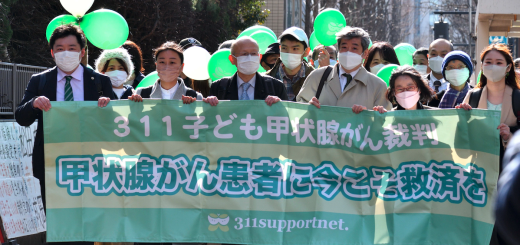Shika-2: Unjust Verdict! Nuke Info Tokyo No. 129
On March 18 the Kanazawa Branch of the Nagoya High Court handed down its verdict on an appeal concerning the Shika-2 Nuclear Power Plant (ABWR, 1,358 MW). The appeal related to a civil suit calling for the termination of construction and operation of the Shika-2 plant. On March 24, 2006 the Kanazawa District Court had accepted the plaintiffs’ claim that the seismic safety of the plant was inadequate and ordered that operations be suspended. However, the High Court overturned this ruling.
Seismic safety was the main point of contention in Hokuriku Electric Power Company’s appeal, but the plaintiffs also raised issues that have emerged since the lower court verdict, including concealment of a criticality incident at the Shika-1 plant and turbine damage in the Shika-2 plant. The High Court rejected the plaintiffs’ case and, judging from the preliminary statement, appears to have accepted Hokuriku’s claims in their entirety.
Three issues related to seismic safety in which the verdict can clearly be said to be unjust are outlined below.
1. Predicted magnitude insufficient
Hokuriku Electric claimed that it was sufficient that the plant be able to withstand a M6.8 earthquake. The court accepted this claim. The court accepted this claim. It dismissed the plaintiffs’ argument that the Southern Hyogo Prefecture Earthquake (1995) and the Western Tottori Prefecture Earthquake (2000) suggest that a M7.3 earthquake could occur anywhere in Japan, even if no earthquake fault has been discovered. The verdict is based on ignorance of the facts. For example, it incorrectly claims that the Western Tottori Prefecture Earthquake was caused by a known fault.
During the revision of the Seismic Guidelines (September 2006) it was proposed that earthquakes in the M7.0 to M7.3 range should be considered. Back checks were mandated under the new guidelines, but the power companies are all proposing that earthquakes in the order of M6.9 are sufficient. Clearly the under-estimation problem applies to all the utilities.
The seismic safety leeway of the equipment in Shika-2 is very low. Even though earthquake magnitude is under-estimated, important safety-related equipment barely meets required safety standards. This can be said of equipment including control rods, pipes in the residual heat removal system, main steam pipes and the containment vessel. These are all items that are supposed to easily meet the standards, given the assumptions used in the calculations. This goes to show how dangerous the Shika-2 plant is. If public safety was the top priority, seismic safety should be assessed on the basis of a much stronger earthquake.
2. Assessment of Ohchigata Fault Zone ignores Headquarters of Earthquake Research Promotion principles
Hokuriku Electric lost the case in the District Court over this issue. In the context of earthquake back checks required under the new guidelines, it increased its assessment of the length of the Ohchigata Fault Zone to 34km. However, this assessment was based on an assessment that the nearby Tsuboyama-Hachiya Fault is a separate fault. The High Court accepted this assessment on the grounds that the shear of the two faults is in the opposite direction.
If the Headquarters of Earthquake Research Promotion’s “5km rule”1 were applied, addition of the Tsuboyama-Hachiha Fault would increase the length of the Ohchigata Fault Zone by 10km, and the seismic safety assessment would have to be based on a 44km fault. In fact, the Headquarters of Earthquake Research Promotion predicts a M7.6 earthquake.
3. Verdict ignores the lessons of the Chuetsu-Oki Earthquake
The verdict cites the government’s safety assessment to justify its acceptance of Hokuriku Electric’s seismic safety claim. However the Chuetsu-Oki Earthquake, which struck the Kashiwazaki-Kariwa Nuclear Power Plant (KK), proved that the government’s safety assessment cannot be relied on.
Hokuriku Electric claims that it has responded to the Chuetsu-Oki Earthquake by taking measures to prevent water from the spent fuel pools from overflowing. It also claims that since only a tiny amount of radioactivity escaped during the Chuetsu-Oki Earthquake, it cannot be said that that earthquake indicates that the Shika-2 reactor is unsafe.
Based on the experience of the Chuetsu-Oki Earthquake, the Nuclear and Industrial Safety Agency (NISA) instructed power companies to consider 1.5 times more violent shaking (still insufficient), but the verdict makes no mention of this point. In relation to the magnitude of the Chuetsu-Oki Earthquake, the shaking of KK was huge. In accepting Hokuriku Electric’s assessment of the magnitude of the earthquake, the shaking of the plant that would result and the seismic spectrograph, the verdict ignores the lessons of the Chuetsu-Oki Earthquake.
The overall verdict is based on the High Court’s acceptance of NISA’s assessment that the Shika-2 plant is safe. However, given NISA’s failure to predict the impact on KK of the Chuetsu-Oki Earthquake, it is clear that NISA’s safety assessment is not a sound basis for judgment. It is also important to remember that Shika-2 was designed and constructed under the old seismic guidelines and that the back checks required under the new guidelines are only a supplementary measure.
Seismic safety assessment of nuclear power plants should demonstrate that the plants are able to withstand earthquakes that could potentially occur in future. This verdict completely fails to address this issue. Instead of inspiring confidence in the safety of the Shika-2 plant, the verdict rather makes us even more worried.
Hideyuki Ban (CNIC Co-Director) and Chihiro Kamisawa (CNIC nuclear safety specialist)
1. The “5km rule” presumes that two active faults within 5km of each other should be treated as a single fault.

